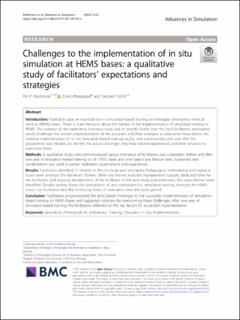| dc.contributor.author | Bredmose, Per Poelhøi | |
| dc.contributor.author | Østergaard, Doris | |
| dc.contributor.author | Sollid, Stephen J. M. | |
| dc.date.accessioned | 2023-02-17T14:58:13Z | |
| dc.date.available | 2023-02-17T14:58:13Z | |
| dc.date.created | 2021-11-29T14:57:07Z | |
| dc.date.issued | 2021 | |
| dc.identifier.citation | Bredmose, P. P., Østergaard, D., & Sollid, S. (2021). Challenges to the implementation of in situ simulation at HEMS bases: a qualitative study of facilitators’ expectations and strategies. Advances in Simulation, 6(1), 1-11. | en_US |
| dc.identifier.issn | 2059-0628 | |
| dc.identifier.uri | https://hdl.handle.net/11250/3052072 | |
| dc.description.abstract | Introduction
Facilitators play an essential role in simulation-based training on helicopter emergency medical services (HEMS) bases. There is scant literature about the barriers to the implementation of simulation training in HEMS. The purpose of this explorative interview study was to identify factors that the local facilitators anticipated would challenge the smooth implementation of the program, and their strategies to overcome these before the national implementation of in situ simulation-based training locally, and subsequently, one year after the programme was initiated, to identify the actual challenges they had indeed experienced, and their solutions to overcome these.
Methods
A qualitative study with semi-structured group interviews of facilitators was undertaken before and after one year of simulation-based training on all HEMS bases and one Search and Rescue base. Systematic text condensation was used to extract facilitators’ expectations and experiences.
Results
Facilitators identified 17 themes in the pre-study-year interviews. Pedagogical, motivational and logistical issues were amongst the dominant themes. Other key themes included management support, dedicated time for the facilitators and ongoing development of the facilitator. In the post-study-year interviews, the same themes were identified. Despite anxiety about the perceptions of, and enthusiasm for, simulation training amongst the HEMS crews, our facilitators describe increasing levels of motivation over the study period.
Conclusion
Facilitators prognosticated the anticipated challenges to the successful implementation of simulation-based training on HEMS bases and suggested solutions for overcoming these challenges. After one year of simulation-based training, the facilitators reflected on the key factors for successful implementation. | en_US |
| dc.language.iso | eng | en_US |
| dc.publisher | BMC | en_US |
| dc.rights | Navngivelse 4.0 Internasjonal | * |
| dc.rights.uri | http://creativecommons.org/licenses/by/4.0/deed.no | * |
| dc.title | Challenges to the implementation of in situ simulation at HEMS bases: a qualitative study of facilitators’ expectations and strategies | en_US |
| dc.type | Peer reviewed | en_US |
| dc.type | Journal article | en_US |
| dc.description.version | publishedVersion | en_US |
| dc.rights.holder | The authors | en_US |
| dc.subject.nsi | VDP::Medisinske Fag: 700 | en_US |
| dc.source.journal | Advances in Simulation | en_US |
| dc.identifier.doi | 10.1186/s41077-021-00193-x | |
| dc.identifier.cristin | 1960986 | |
| dc.relation.project | SHARE - Centre for Resilience in Healthcare: 5091 | en_US |
| cristin.ispublished | true | |
| cristin.fulltext | original | |
| cristin.qualitycode | 1 | |

